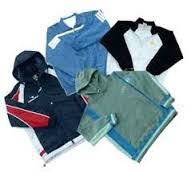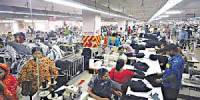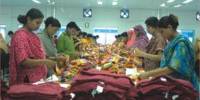Introduction:
The economy of Bangladesh is largely dependent on agriculture. However, in recent years, the ReadyMade Garments (RMG) sector has emerged as the biggest earner of foreign currency. The ready-made garment (RMG) sector has experienced an exponential growth since the 1980s. The sector contributes significantly to the GDP. It also provides employment to around 4.2 million Bangladeshis, mainly women from low income families which affects their social status.The hundred percent export-oriented RMG industries have experienced phenomenal growth during the last 15 years. Within a very short period of time, it has attained great importance in terms of its contribution to GDP, foreign exchange earnings and employment and also as a vehicle of social changes. The export earnings data of Bangladesh shows that in 19884-85, ready-made garment sector earned 12.39 %( $116 million) of the total export. This was raised to 36.46 %( $471 million) in 1989-90. This share rapidly went up to 53.36 %( $1064 million) in 1991-92. Surprisingly, the share showed no increase for the last three years. Bangladesh garments products are facing various barriers and difficulties in the international market. Garments’ contribution to the total export earning remained constant at around 52% for the years (52.84%) in 1994-95 and 52.63% in 1995-96. The total amount of RMG export in 2004-05, 2005-06 and 2006-07 was $5689.09 million, 7900.80 million and 4730.36 million. This is the current situation of RMG export from Bangladesh.
History:
The first ready-made garment factories in Bangladesh aimed at the export market were opened in the late 1970s by investors from other Asian countries whose exports had been restrained by quotas imposed by importing nations. By the mid-1980s, the ready-made garment industry had become a strong export earner. Garment exports brought receipts of only US$3 million in FY 1981, but by 1984 exports had risen to US$32 million, and the following year revenue soared to US$116 million. For FY 1985 and FY 1986, ready-made garments were the second biggest foreign exchange earner for Bangladesh after jute.
The surge in Bangladeshi exports eventually caused a reaction among some industrial nations. Canada, the European Economic Community, and the United States expressed concern that inexpensive Bangladeshi garments were flooding their markets. In 1985, after a series of notices as called for by multilateral agreements, the United States–which was the destination of about 25 percent of Bangladesh’s garment exports–began imposing quotas on Bangladeshi garments, one category at a time.
Bangladeshi manufacturers, working with the government, organized with remarkable speed and efficiency to adapt to changing conditions. They policed themselves to stay within quotas, allocating production quotas according to equitable criteria, and began diversifying their production into categories where there were not yet quotas: for example, cotton trousers, knitwear, dresses, and gloves. After a period of adjustment, during which some of the least well-established firms closed and workers were laid off, the industry began stabilizing, and growth continued at a more moderate pace. Exports in FY 1986 rose another 14 percent, to US$131 million, and prospects were good for continued growth at about that rate.
The ready-made garment industry in Bangladesh is not the outgrowth of traditional economic activities but emerged from economic opportunities perceived by the private sector in the late 1970s. Frustrated by quotas imposed by importing nations, such as the United States, entrepreneurs and managers from other Asian countries set up factories in Bangladesh, benefiting from even lower labor costs than in their home countries, which offset the additional costs of importing all materials to Bangladesh. Bangladesh-origin products met quality standards of customers in North America and Western Europe, and prices were satisfactory. Business flourished right from the start; many owners made back their entire
Capital investment within a year or two and thereafter continued to realize great profits. Some 85 percent of Bangladeshi production was sold to North American customers, and virtually overnight Bangladesh became become the sixth largest supplier to the North American market.
Country’s RMG producers have been steadily moving towards high value sophisticated items like high quality suits, jackets, branded jeans items, embroidered ladies’ wear etc. Increasing at the rate of 27% per year over the last several years,. major share of the country’s RMG export market from the very beginning was led by US followed by EU. But during 1995, EU overtook the US. Among countries in EU, Germany has been topping the list over last several years followed by UK, France, Italy and The Netherlands. In 1995, Germany imported apparels worth US$ 317.86 million against US$ 245.39 million in 1994. Only Shirts and T-shirts that Germany imported in 1995 were worth US$ 202.36 million. As single country, however, US have been the highest apparel importing country for Bangladesh. (GOB 1996) Bangladesh Statistical Yearbook, 1995, Dhaka: BBS, BGMEA: 1996.
Objectives of the Study:
To know the existing position of Bangladesh garments in international market;
To identify the difficulties and barriers faced in the international market;
To identify possible threats to the Bangladesh garments in the international market in near future;
To identify the opportunities of the Bangladeshi garments that may be realized in the international market.
To recommend the measurers needed to be taken for increasing the export volume.
To full fill the course requirements.
Methodology:
Since this study is clinical in nature, a number of techniques were used to collect the required information. Both primary and secondary information were collected. Primary technique involved Questioning BGMEA officials, in addition in depth interview of prospective exporters and experts were also undertaken. Secondary study involved the study of existing literature and available documents of the exporters were also used.
Information has been collected from both the primary and secondary sources. Potential sources were BGMEA, export directory, BBS reports, International Trade Bodies of UN; various journals, magazines and publications of BEPZs.
Limitations of the study:
- Information related to RMG export was not available
- Recent information are hard to collect
- Experts are not willing to give interview
- Last but not the least time was very short to do such a study.
Those are the limitations of this study that I faced in doing the study.
CHAPTER ONE: AN OVERVIEW OF RGM
Ready Made Garments Export Condition in brief:
The Bangladesh Garment Manufacturers and Exporters Association (BGMEA) is the only recognized trade body that represents the export oriented garment manufacturers and exporters of the country. Struck by the 70s’ political turmoil in Sri Lanka and price hike in other Asian countries, garment buyers in the international markets explored the potential of the newly born Bangladesh. Fortunately, with the timely policy support from the government, entrepreneur’s talent and efforts as well as the labor of the work force, the ready-made garment (RMG) industry could impressively succeed and the buyers got confidence in it. Now its development rate is, on an average, 20% per annum.
Starting in late 70s as a small nontraditional sector of export. Ready-made Garment (RMG) emerged as a promising export earning sector of the country by the year 1983. Bangladesh at that time lacked a sectoral trade body, non-government in nature, free from traditional bureaucracy, to help the sector to boost up the country’s foreign exchange earnings. Entrepreneurs and the government in the post independence years felt and emphasized the urgent need to develop non-traditional items of export for helping the struggling economy. As a result, 1977 marked the birth of Bangladesh Garment Manufacturers and Exporters’ Association (BGMEA). Since its humble inception with only nineteen (19) garment manufacturers and exporters, BGMEA has grown into a strong and dynamic body. Today it proudly declares registered membership of more than 2700 garment manufacturers and exporters. Of the total 2700 units, about 1932 garment factories are located in Dhaka while about 1 55 and 415 factories are located in Naryanganj and Chittagong respectively. Factories are located in Dhaka while about 1 55 and 415 factories are located in Naryanganj and Chittagong respectively. These 2700 garment factories having about 1.5 million workforces is earning 73% of the country’s total foreign currency. About 1 5 million people are directly dependent on this sector. The growth of Freight Transport, Bank, Insurance, hotel etc. in the country is the gift of the garment industry. In a nutshell, the garment industry has become the pivot of the country’s economy. The fundamental objective of BGMEA, however, is to establish a healthy business environment for a close and mutually beneficial relationship between the manufacturers, exporters and importers in the process ensuring a steady growth in the foreign exchange earnings of the country. To this end, BGMEA has been playing a very strong role to lead the industry in concurrence with the government. The following are the regular activities of BGMEA for its members, owners, apparel buyers and other partners.
BANGLADESH: SPECIAL FEATURE:
The competitive strength of a firm or a country in the market depends on its specific comparative advantage(s), which its competitors do not have. A particular uniqueness of a supplier shapes up its strategic advantage profile. In case of Bangladesh, this uniqueness is the unlimited availability of unusually cheap but usable labor. It is the abundant supply of the comparatively cheap labor that stands out as the significant strength. The RMG industry by its nature is a low technology but labor intensive industry. The workers can be employed at very low wages, not only in comparison with other competitor countries, but also in comparison with other domestic industries in Bangladesh. In domestic market as well, the wages of the workers of the RMG industry happen to be the lowest. This should be apparent from the figures presented in Table – 1.
TABLE – 1
AVERAGE MINIMUM WAGES OF RMG INDUSTRY AS % OF AVERAGE MINIMUM WAGES OF 12 SELECTED INDUSTRIES
| Sector/ Industries | Percentage (%) | Sector/ Industries | Percentage (%) | |
| Jute Bailing | 83 | Cold Storage | 72 | |
| Match | 83 | Pharmaceuticals | 79 | |
| Hosiery | 86 | Shoe | 83 | |
| Re-rolling | 70 | Petrol Pump | 77 | |
| Printing | 92 | Fishing Trawler | 57 | |
| Cinema | 86 | Road Transport | 72 |
Source: Adapted from World Bank Report no. 11569-Bangladesh, March24, 1993, Table‑3.6, p-96. (Siddiqi: 1996)
The figures in Table – 1 indicate, for example, that the average minimum wage of the workers in RMG industry in 1992 was 83% of that in jute bailing industry, 70% of that in re-rolling industry, and so on. All the 12 industries included in Table – 1 paid average minimum wages, which were higher than that of RMG industry.
In highly competitive international market, it is the price and quality, which determine the competitive position of a supplier. On the account of price, Bangladesh can beat all its competitors. Price is related to cost of production which in case of apparel industry is greatly determined by the labor costs. Wages in Bangladesh are remarkably low. Naturally it will continue to enjoy competitive advantages in international markets because it has virtually unlimited supply of cheap labor who can learn the low technology operation necessary in producing RMG without much investment in terms of money and time. Bangladesh has a tremendous labor-cost advantage that can be seen by looking at the comparative average hourly wages (including fringe benefits) of some 19 countries, both developed and developing, presented in Table – 2. (Siddiqi: 1996)
TABLE – 2
COMPARATIVE AVERAGE HOURLY WAGES IN RMG INDUSTRY
| Germany | US$ 25.00 | Egypt | 0.60 | |
| USA | 16.00 | India | 0.60 | |
| South Korea | 5.00 | Sri Lanka | 0.45 | |
| Hong Kong | 3.90 | Pakistan | 0.40 | |
| Turkey | 3.50 | Indonesia | 0.40 | |
| Mexico | 2.40 | Vietnam | 0.40 | |
| Brazil | 1.50 | China | 0.35 | |
| Poland | 1.40 | Nepal | 0.25 | |
| Malaysia | 1.20 | Bangladesh | 0.20 |
Source: The Economist, October 1-7, 1994 and “ITC: Textiles and Clothing: An Introduction to Quality Requirements in Selected Markets”. ITC/ UNCTAD/ GATT, Geneva, 1994. (Depending on the sources of data, the wages rate may vary).
From Table – 2, one can easily see that the labor cost is the lowest in Bangladesh. It is to be noted that the wages should be examined in the context of the stage of development a country has achieved and in terms of productivity. Therefore, the real cost differentials between rich and poor countries may not be as wide as they appear in the Table – 2. As is expected, the rich developed countries’ wages are likely to be much higher than that of Bangladesh. In most cases, higher wages are justified, at least partly, by the higher productivity of the workers. Their productivity is higher because of high degree of automation; the workers are better trained, well disciplined, supervised by better management, and above all the higher cost of living. Therefore, the cheapness of labor in Bangladesh must be considered along with the level of productivity. In any way the rich countries are not our competitors. It is the developing countries, which are. As far as our competitors are concerned, the comparative productivity must be considered. In terms of productivity, Bangladesh does not have any special advantages. Simply because Bangladesh pays the lowest wages to its workers, it does not necessarily mean that labor or total productivity is the highest in Bangladesh. In many of its competitor countries, productivity is much higher. For example, the total man-hour required to produce a shirt of a particular specification in Bangladesh is higher than that in Sri Lanka or Malaysia. However, for the time being, cheap labor compensates for the relative low productivity. One may note that the wages in most of the Southeast Asian and other competitor countries are increasing at much faster rate than that in Bangladesh. This may possibly allow Bangladesh to maintain its strength in terms of cost advantages for longer time in future.
RECENT GLOBAL TRENDS IN TEXTILE AND GARMENTS:
Today, total trade in textiles and apparel amounts to approximately US$ 128 billion, and it is growing rapidly, total trade is almost evenly divided between textiles and apparel, the former amounting to approximately US$ 66 billion and the latter to US$ 62 billion over the last three years. With the exception of Italy and Federal Republic of Germany, all industrial economies have become larger net importers of textiles over the period, with the United States taking the lead, while a small group of developing countries (Korea, Taiwan [China], China, Hong Kong, and Turkey) have increased their standing as major net exporters. Since the middle of the 1980s, the Federal Republic of Germany has emerged as the single largest importer and exporter of textiles (both yarn and cloth), gradually reducing but not eliminating its deficit in textile trade. The Federal Republic of Germany has restructured its textile industry over the past decade to increase the degree of specialization and to carve out a market niche at the high quality end of the market. It has eliminated most manufacturing at the lower end of the market in favor of outward processing and now depends largely on imports from developing countries to meet its demands for low value added products. Its production is concentrated at the high value added and high quality end of the market and is not threatened, at least for the time being, by competition from the NIEs. A similar pattern of restructuring and specialization is observed for Italy and Japan (both of whom have become the largest net exporters), Belgium, Netherlands and Switzerland, which have all preserved a positive net, export position while importing a substantial portion of their yarn and cloth requirements. On the other hand, the United States, United Kingdom, and France are primary examples of other industrial economies that have not been able to match their low-value textile imports by exports and have become net importers (Pepper et.al. : 1994).
Among the developing economies, the NIEs, particularly Korea, Taiwan [China], and China have emerged as major exporter’s low-to-medium value added textiles. This is now an intensely competitive segment of the global market, one of which many developing countries has been struggling for a share. Hong Kong is a large net importer of textiles from the developing countries, for re-export after finishing or for garment manufacturing; until recently, Hong Kong was not a significant producer of textiles but in the last decade its output and export of textiles have increased rapidly following modernization and development of its spinning and weaving capacities. Similar developments, although on a somewhat smaller scale, have occurred in Taiwan and Argentina. On the other hand, some developing economies (India, China, and Pakistan in particular) that were previously concentrating on gray yarn and cloth exports have recently entered into garment exporting with considerable success. Finally, there are many developing countries (such as Sri Lanka, Bangladesh, Mauritius, Tunisia, Morocco, Bahamas, and Costa Rica) because of low wage rates have attached investment in garment manufacturing (often through subsidiaries of companies in industrial countries). Generally speaking, these countries have not developed textile-manufacturing capabilities and must import their yarn and cloth requirements.
THE EXTERNAL THREATS:
Bangladesh has successfully established a remarkable presence in the world markets, particularly in the US and EU markets. If one analyses its external threats and opportunity profile, one finds that its powerful competitors will try to influence the trading environment in such a way as will create hurdles for Bangladesh to retain or improve its competitive edge. This hurdle can take numerous forms. Broadly, these are discussed in two categories: (1) Phasing out of MFA and (2) Other non-tariff barriers.
Phasing Out of MFA:
It seems that the phenomenal growth of RMG exports from Bangladesh has become a threat to its powerful competitors. Naturally, they (the competitors) are preparing to snatch away the markets from Bangladesh with aggressive and “innovative” business strategies. They will certainly take advantages of the new provisions included in the final Acts of Uruguay Round. One such provision is the phasing out of the MFA.
Before we can answer the question whether the phasing out of MFA will be a threat to Bangladesh, we need to understand the origin and meaning of MFA (Multifibre Agreement). The GATT did not originally include textile and apparel industries in its principles of MFN (Most Favored Nation). The Uruguay Round (UR) decided to integrate textile and RMG industries into GATT system. As is well known, GATT/WTO prohibits not only unjustified tariff barriers but all forms of non-tariff barriers including imposition of “quota”. In sixties, while GATT principles prohibited discrimination between the trading partners, it allowed certain exceptions to GATT principles on the ground of “fairness”. Such an exception is MFA. The United States and several other developed countries argued that if the developing countries which enjoy comparative advantages in terms of labor costs are allowed to export RMG without any restrictions to the cost-disadvantaged developed countries, the textile and apparel industries in the latter countries will be injured. They strongly felt that the interest of the domestic textile and apparel industries of the USA and other developed countries where labor cost is very high must be protected in way, which is recognized by the GATT. To achieve this goal, a special provision known as
MFA was instituted. Under the MFA provisions, GATT allowed the USA and other importers of RMG to impose quota restrictions (use of trade restrictive quota is not permitted by GATT except in this case). The MFA has been in place since 1974. Later on when trade liberalization policy started riding high, the arguments for phasing out the MFA were put forward by those countries, which were hurt by it (Siddiqi: 1995, Raffaeli: 1994). After grueling debate, the final Uruguay Round negotiations envisaged the phasing out of MFA by the year 2005, within 10 years beginning July 1, 1995 (Goto: 1990).
After the year 2005, if MFA is really phased out, these countries, to be more specific, companies from these countries that have collaboration with our entrepreneurs, may not be our partners – in – progress due to the changed circumstances. Under the changed circumstances, all countries including those, which are now under quota restrictions, will be on quota-free status. In fact they will probably emerge as our stronger competitors. This means that Bangladesh will have to compete with a larger number of established and powerful suppliers of ready-made garments, namely, China, Hong Kong, Singapore, Indonesia, Malaysia, India, Pakistan, Sri Lanka, Egypt, etc. in the world markets on the equal terms and of its own. In addition, Vietnam, Poland, Brazil, and small countries of Caribbean region are likely to emerge as new competitors (Quddus: 1996).
Some people fear that the RMG exports of Bangladesh may be driven out from the world market. But we believe that if Bangladesh can take certain measures, it should continue to do as well as it is now doing. To retain its competitive edge, it needs to:
i) Make substantial development to labor productivity and managerial efficiency through the effective training efforts.
ii) Look for new product development and diversification along with new venues of markets.
iii) Make structural development to textile and RMG industries with appropriate backward and forward linkage.
Other Non-Tariff Barriers:
The final Acts of the Uruguay round (UR) negotiations expanded, integrated and strengthened the GATT principles of reducing / eliminating all forms of trade barriers with a view to increase world trade. It is easier to identify and remove trade restrictive tariff barriers because they take so many and such subtle forms that multilateral negotiators face more disagreement than agreement on their definitions. For example, customs evaluation procedures suitable in a particular country may be interpreted as deliberately created non-tariff barriers by its trading partners. Similarly, there is a scope for “misinterpretations” of subsidies given to exporters by the respective government. The child labor, environmental and human right issues are also susceptible to similar “misinterpretations”(Jonokontho : 1995).
Quota System:
For decades the world’s garment trade has been governed by a system of quotas. It limited the amount efficient countries like China could export to the big markets of the United States and Europe. The original intention was to protect the garment industries in the West. But the effect was to guarantee less developed countries like Bangladesh a slice of the trade. Quotas were abolished from 1 January 2005. Retailers are now free to buy from whatever country can make garments for the lowest price. It could mean cheaper clothes for consumers but the pain will be felt in slums in the developing world.
Competitor:
Competition has become intense in the garment industry at present. Garment industry is emerging rapidly in Taiwan, Hong Kong, Singapore and Korea in Asia. Thailand, Malaysia, Indonesia, Philippines and Sri Lanka have found the garment industry more attractive to develop their economy from 70’s decade. Vietnam has become a potential entrant in garment industry throughout the world.
Threat from Various Regional Organizations (Such as NAFTA, EEC, EFTA, etc.):
The trend of the modern world is regionalism to strengthen the economy of the member countries through co-operation. North American Free Trade Association has been signed recently and the main initiator of NAFTA is the USA, who is the main buyer of garment from Bangladesh. According to the treaty of NAFTA, USA will invest its domestic resources to develop their economy by using 60% of their own raw materials through utilizing the low cost labor of Mexico. So, it is a potential threat to the garment industry of Bangladesh. On the other hand, EC countries have already declared a single currency for European Common Market called ECU (European Currency Unit) to protect the interest of the member countries through co-operation. This sort of protectionism is great threat to the garment industry of Bangladesh, because Germany, Britain, Denmark, Norway, Belgium, Italy, etc. are buyers of the garment of Bangladesh.
Scarcity of Raw Materials:
There is no alternative of ample supply of raw materials in order to become self-sufficient in any industry. The raw materials of the garment industry of Bangladesh are foreign dependent. Bangladesh has to import raw materials of garments from abroad in order to process it in Bangladesh. About 70% of garment export income has to be spent for the raw materials. Moreover, the export and import policy of Bangladesh is very weak. So, the scarcity of raw materials for the garment industry in Bangladesh is a great threat.
Political Instability:
Bangladesh is not a stable country politically. Political instability is a great threat for any industry of our country. Frequent strikes and hartals are great obstacles for the growth of any industry. The production cost increases and productivity decreases because of frequent hartals and strikes. Garment producers cannot keep their contract with buyers because of hartals and strikes. Hartals and strikes have become a common phenomenon of Bangladesh. There is a positive relationship between law and order situation of any country and export. If the law and order situation improves, the volume of exports increases. Unfortunately, the political stability and law and order situation is not in favors of the export of our country and becoming a threat to our export trade day by day.
The Child Labor Issue:
It is quite likely that by restructuring the industry and improving the productivity and managerial efficiency, Bangladesh will be able to compete in the international markets. But problem will arise if the importers apply subtle non-tariff barriers under the disguise of humanitarian and environmental arguments. For Bangladesh, the problem is not how to cope with the technical and cost reduction problems; the real problem is how to tackle the problem of such non-tariff barriers. As an example, one can cite the child labor issue. The much-talk about the “Child Labor” issue can be an effective non-tariff barrier. The Harkin’s Bill designed to prevent the abuse of child labor is a prima-facie based on humanitarian ground. But many people will contest the basic logic.
Business Consideration:
Replacement of some 12000-child labor now working in Bangladesh RMG factories by older and more experienced workers will increase the production cost. But given the wage structures in Bangladesh, it will not be an amount to be concerned about. Another cost is to be added. The stipend-support and schooling of the terminated children will cost the industry some money. If the total cost is shared by the industry, it is not likely to increase FOB price to a level, which will make RMG less competitive in the world market.
Recent activities:
US may relate increase in garments export quota to labor standard, BGMEA hopeful of success in negotiations on US market access:
As the negotiations for the Bangladesh government’s request for a 30 per cent rise in the export quota of ready-made garments to the US market are likely to begin early next month, the leaders of the country’s apparel industry are pinning great hopes on its success.” We are surely going to get a rise in the export quota as a reward for the elimination of child labor. There is no doubt about it,” President of the Bangladesh Garments Manufacturers and Exporters Association (BGMEA). This will be in addition to a 10 per cent annual graduation of export quota in the US market, he said. But another source close to the industry, however, apprehended that the US administration may relate a rise in the special quota allocation to compliance with core labor standard and some other conditions. In this connection, he referred to the recent 14 per cent special export quota allocation by the US to Cambodia for 1999 and said the compliance with the labor standard had been made conditional on it. If the Cambodians failed to implement the core labor standard issues, the offer would be taken back, said the source referring to information received here last week. The same may be the case for Bangladesh, he said. But Quddus said there was no justification for such apprehension. The source said the Bangladesh embassy in Washington and the BGMEA’s lobbyist in the US capital, former senator Solartz, was coordinating efforts to win a best deal. The Foreign Ministry and the Commerce Ministry in Dhaka were also doing their homework at this moment. They had held several meetings recently and were waiting for a call from Washington to attend the negotiations. The source said the country’s apparel makers were already implementing the core labor standards. These include good working conditions, health and hygienic standards, safety measures and proper and regular payment of wages and overtime. Many garments manufacturers have already installed additional facilities and updated their system to comply with the requirements. Others were on their way, said a source.” It is a big challenge after the child labor elimination,” said a functionary of the BGMEA, the umbrella organization of the country’s apparel makers.” But it is part of the game now and we will face it in the way we very successfully faced and solved the child labor issue,” he said. The source said the US administration may also take up the issue of the Bangladesh government’s delay in amending the law allowing trade union activities in the Export Processing Zones (EPZ).In fact, the US administration was insisting, over the last five years, on restoring to the EPZ workers the right to form trade unions, including their right to elect collective bargaining agent. The government was quite appreciative of the US concern, said the source adding, but it had to honor the commitment made to investors in the EPZ as well. Under that commitment, the investors in the special economic zone are to be free from trade union activities. He said; actually the workers in the EPZ were better paid. The question is of principles. The government can only pursue the matter. It can’t do anything arbitrarily. This is why is causing the delay, he said hoping that all sides would appreciate the problem so that a solution acceptable to all could be sorted out soon.
The other issue likely to come up during the negotiation is the problem of the adolescent workers, those from 14 to 18 years of age. The US government wants that they work only four hours a day and during the remaining part of the day, take lessons for becoming skilled workers. The BGMEA source said that a lot of progress had already been achieved in this regard. It was now implementing a new scheme called ‘earn and learn’ for these people and about 1300 newly developed skilled workers trained under this program would be joining new jobs very soon. They have been trained as paramedics, technicians etc, said the source. He said the Bangladesh garments industry was capable of complying with any requests that would benefit the buyers, workers and the industry as a whole. “What we need is understanding and cooperation,” he pointed out. The BGMEA functionary declined to comment on the possible tying of the labor standard and other conditions to a 30 per cent rise in Bangladesh’s export quota to the US. He said there was no reason why Bangladesh and Cambodia should be treated on an equal footing. Bangladesh is a big apparel exporter to the US and also has a bilateral trade agreement for long with it, unlike Cambodia.
OPPORTUNITIES OF READY-MADE GARMENTS INDUSTRY:
Bangladesh has opportunities of expanding the market through the following strategies.
- Cost Effective Strategy
- New Product Development and Diversification Strategy
- Market Diversification Strategy
Combined together these three strategies calls for total quality management (TQM) approach. I have discussed them individually.
Finally it can be said that Bangladesh has a very bright future in exporting Ready Made Garments.
CHAPTER THREE: Analysis of Findings
Bangladesh economy to grow at 6 percent despite key challenges: IMF
Bangladesh’s economy is expected to grow six percent next fiscal year despite the abolition of quotas for textile exports that was predicted to cause massive job losses, the International Monetary Fund said in a report posted Tuesday. The economy grew 5.5 percent in the fiscal year ended June 30.The IMF forecast is in line with a finance ministry budget estimate in June that said the economy was recovering from devastating floods last summer and had coped well in textile exports despite the loss of quotas that opened up competition with larger rivals Such as China and India.
The international textile quota system, known as the Multifibre Arrangement, was abolished at the end of December 2004 prompting predictions that as many as one million jobs would be lost in Bangladesh.
In the year to June 2004, Bangladesh exported goods worth 7.56 billion dollars with textiles accounting for 75 percent. “Looking forward, (the IMF) underscored that Bangladesh faces the key challenges of accelerating growth and maintaining macroeconomic stability while overcoming the potentially significant impact of the MFA phase-out,” the IMF said.
US LAWMAKER ASSURES ALL STEPS TO MAKE DUTY FREE ACCESS OF RMG:
All steps including lobbying in the representatives council, will be taken to pass the Trade Act 2005 in the Congress to enable duty-free excess of Bangladesh’s ready-made garments and other exporting items to the US markets.
One of the most influential caucus members of Bangladesh and elected Democratic Party member from Virginia Christ Van Hollen said this when a expatriate Bangladeshi delegation met him 12 March 2005 at Capital Hill. During the meeting Congressman Christ said Bangladesh is a glaring example of a democratic state in the World. Terming Bangladesh, as a friend of the USA, he said discussions will be held with other Democratic Party members to turn the act as a law which was placed in the Congress. President of the America Bangladesh Chambers of Commerce Gias Ahmed, Executive Director Abdul Latif Shamrat and BNP’s Washington Unit General Secretary Sharafar Hossain Babu led the delegation.
The LDCs Conference:
With the phasing out of Multi-Fiber Agreement (MFA), the readymade garment industries of the countries, which have weak textile base, are feared to be in the brink of an uneven challenge. There have been widespread concerns by the exporters and experts about the possible fate of the countries garment exports, which, the experts think can only get special support if more preferential access to the US market, the biggest destination of local RMG products, could be achieved.
With that aim in view, the BGMEA took the pioneering role in placing a trade bill in the US congress, which, if passed into law, will benefit 14 LDCs including Bangladesh. To strengthen the efforts, the association has taken a landmark decision to hold a conference of the stakeholder LDCs in Dhaka in June to garner their support in favor of the bill.
Meanwhile, tremendous response has been received from the invitees. It is indeed a vivid demonstration of the wisdom of the current BGMEA leadership, which is expected to be culminated into having a joint declaration participant at the end of the conference.
LDC products: low-price garments in a higher-quality market:
In clothing as in cotton fabrics, the LDCs tend to focus on exporting standard products such as T-shirts, men’s shirts, and woven and printed fabrics, for which price is the main determinant of success and in-depth knowledge of fashion and design trends is not essential. However, in recent years a change has been taking place in the developed markets, away from cheap imports towards better-finished, higher-quality casual fashion and more individual clothing, the opposite of LDC garment exports.
Nevertheless, Bangladesh has a number of ‘champions’ export products (i.e., achieving high growth in a dynamically expanding market), particularly women’s knitwear. Haiti, another example of a textile-exporting LDC, has been doing very well with exports of cotton T-shirts and women’s clothing. Its garment exporters are
Gov trying to overcome problems in RMG sector:
Speakers at a seminar said the government is making all out efforts to overcome the problems of garments sector and trying for duty free and quota free access of Bangladeshi goods to the US and European markets, reports BSS.
The sector is the main foreign currency earner, which earned 70 per cent of the country’s total exports last year. EPB Vice President said that Bangladesh has got duty free access to Australia from 1st July. It is the 4th country to give duty free opportunity for Bangladesh products. Earlier Canada, Japan and Norway have given duty and quota free access of Bangladeshi products. (CHITTAGONG, Apr. 19)
WB predicts 5.5 pc GDP Growth:
Bangladesh made faster economic growth:
The World Bank on Sunday said Bangladesh made faster economic growth in last two financial years and predicted that the projected 5.5 per cent growth of this year’s gross domestic product (GDP) was ‘very likely’ to be achieved owing to good rice harvests, reports BSS. The export performance also marked a steady progress with 16.2 per cent increase in first seven months of the current fiscal. The export of readymade garments (RMG)- both woven and knitwear-has picked up due to increase in global demand and the consolidation process in the industry, which earns over 70 per cent export earnings.
The Fastest Growing Export Sector of the Country:
Starting in late seventies, the apparel industry of Bangladesh now accounts for over 64% of the country’s total export earnings. Country’s apparel export rose to US$2628 million in 1996 from a mere US$6 million in 1981. To about 30 countries around the world, Bangladesh presently exports ready-made garments, with over 45% to USA, 50% to the countries in EU and 3% to Canada and rest to the other countries of the world. Country’s apparel export has been growing on an average at the rate of 25% for last several years. The country, last year ranked 6th largest apparel exporter to the USA the EU.
Bangladesh Garment Export:
There are about 2500 export oriented ready-made garment industry in Bangladesh those are clustered over mainly Dhaka and Chittagong. Such distribution offers buyers advantage to choose the right manufacturers and exporters, throughout the year, with minimum effort.
Ready Made Garments Export Data
CONCLUSION:
In order to sustain the smooth growth and development of the garment industry of Bangladesh, Government should play a key role to offer a good export policy. Otherwise the production, employment, earning of foreign currency and economic development of the country will be affected seriously. Some recommendations have been offered to face the problems of the garment industry of Bangladesh.
Regarding the problem of RMG sector I’ve identified some recommendation for the betterment of this sector. The recommendations are as follows:
- The Government of Bangladesh should play a key role for the expansion of the market of garment by diversified items for manufacture and export. It is very important fact that there are many items in the RMG product lines which Bangladeshi entrepreneurs have not yet started production. Leather items, life jackets, gloves, bags etc. are among few such items. Among other items are umbrella, nylon school bags and jackets, ice sport kits and wears, staffed toys, high competitive market fashion garments are examples. There are numerous such items not yet touched by our entrepreneurs.
- All out efforts would be made and steps taken for production and export of high priced readymade garments in the light of the prevailing market demand.
Immediate steps shall be taken to establish a Fashion Institute pending establishment of the Fashion Institute measures will be taken, under special arrangements, to extend expert services to match the actual demand.
Liberal credit may be considered for capacity building and hiring technology for producer of high quality garments.
Product-Specific decisions: Readymade Garments:
Provisions have been made for the exporters of readymade garments to retain in their respective foreign currency accounts the portion of their export earnings required for meeting the expenses on importing fabrics and other accessories through back-to-back letter of credit. The exporters that way shall be saved from incurring losses by first converting their export earnings to Taka and then re-converting the same to foreign exchange for payment of import bills on raw materials.
Labor Productivity Improvement:
However, it is to be noted that the lower material procurement cost may not be enough for Bangladesh to maintain its competitive edge in international markets. Bangladesh must increase productivity, which is lower than many of its competitors. It is true that wages are low in Bangladesh, but it does not necessarily mean that relatively low wages automatically lead to higher productivity. Wages are only one of the determinants of labor productivity. Time required by the workers to perform a task is another important determinant. Available efficiencies indicate that Bangladeshi workers are not as those of Hong Kong, South Korea and Sri Lanka. The workers’ skills and supervisors’ managerial efficiency are higher in those countries than in Bangladesh. In addition, those countries use the latest technology, for example, computerize sewing machines, design facilities, etc. but Bangladesh uses relatively older technology.
RECOMMENDATION:
Special attention needs to be given to Agreements on Subsidies and Countervailing Measures, on Safeguards, and on Anti-Dumping.
- The industry will need to be careful about observing the WTO rules and regulations
- Governmental support is to be considered to ensure that it is consistent with the provisions of the WTO.
- Bangladesh must put its house in order in the spirit of public private partnership
- The backward linkage industries need to be developed
- LDCs like Bangladesh should be given duty-free and quota-free access for all products, at a time, in fulfillment of the commitments
- Extension of duty free & quota free market access by all newly industrialized countries.
- Stringent and binding WTO disciplines should be introduced to facilitate the removal of existing barriers to market access that adversely affect LDCs export interest.
- Relaxation of Rules of Origin under the GSP.
- Inclusion of S & D status for LDCs in the ATC by suitably amending the Agreement.
BIBLIOGRAPHY
- BGMEA (1996), Booklets and Brochures of BATEXPO’96 held on 3-5 October, 1996.
- Booklets and Brochures of BATEXPO’2005 held on 29-01 October 2005.
- Report of Assistant Professor Mr. Abu Yousuf Md. Abdullah, Institute of Business Administration, University of Dhaka. 1996.
- GOB (1996), Bangladesh Statistical Yearbook 1995, Dhaka: BSS.
- Jonokontho Report (1995) Joktorastrey Borjoner Mokhey Bangladeshi Garments, May 22, 1995.
- Ahmed, Abu (1994), Amader Garment Shilper E Shudin Naa-o-Thaktey Parey. The Daily Sangbad, April 27, 1994.
- Ahmed, Redwan (1994), and Garments Industry: Export Potential, Bangladesh Observer, May5, 1994.
- GATT (1984), Textile and Clothing in the World Economy, Spec. (84) 24.
- Quddus, Munir (1996), Bangladesh Garments Sector: The End of Miracle? Bangladesh Observer, May15, 1996.
- Siddiqi, H. G. A. (1995), Emerging Competitors and in Global Apparel Markets: Strengths, Weakness, Opportunity and Threat Analysis. Keynote paper presented at the BATEXPO’95, October 4-5, 1995.
- The Bangladesh Observer (Tuesday, April 20, 2004
- http://www.bangladesh.net
- Bangladesh Country Paper on Ready Made Garment Industry of Bangladesh Presented by: Md. Hossain Ali, Economic Consultant The Dhaka Chamber of Commerce and Industry.
- BBC NEWS World South Asia Bangladesh garments aim to compete.htm
- DWCORP Ltd. “Export policy report” –June 30, 1999.
- financialexpress.Com FE Report Friday September 30, 2005VOL NO REGD NO DA 1589
- expolitz.com Garments-Bangladesh. (Data as of September 1988)
- www.bgmea.com
- International Trade Forum – The quarterly magazine of the International Trade Centre Textiles and Garments.htm
- bangladeshgarments. Info
- News letter of BGMEA issue March 2005
- Www. google.com
- Www. yahoo.com
















